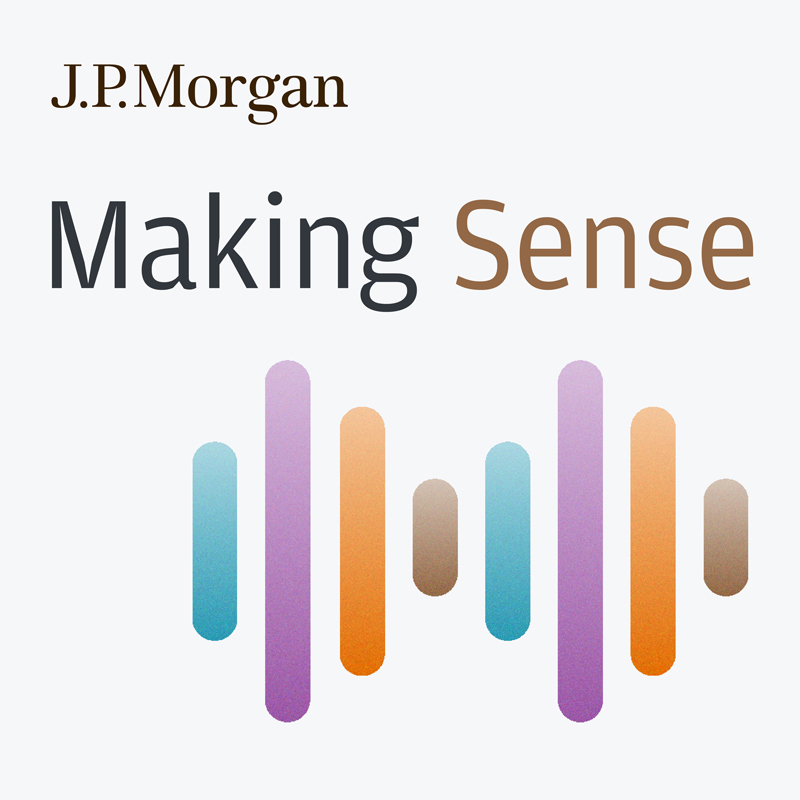
Key takeaways
- A stablecoin is essentially a cryptocurrency designed to maintain a stable value relative to a certain asset.
- They are less volatile than other cryptocurrencies, making them a relatively reliable medium of exchange within the blockchain universe.
- However, they also have significant run risks, which could pose a threat to financial stability.
- Overall, J.P. Morgan Global Research projects the stablecoin market could hit $500–750 billion in the coming years.
Stablecoins have been around for over a decade, beginning with the launch of the now-defunct BitUSD token in 2014. Today, they are in the spotlight once more thanks to the Guiding and Establishing National Innovation for U.S. Stablecoins Act (GENIUS Act), which was signed into law in July and provides a regulatory framework for their adoption and issuance.
“Stablecoins seem here to stay. A few years ago, we probably would have debated the accuracy of that sentence. Not today,” said Teresa Ho, head of U.S. Short Duration Strategy at J.P. Morgan.
What exactly are stablecoins, and what are their pros and cons compared with other forms of cryptocurrency?
What are stablecoins?
A stablecoin is essentially a cryptocurrency designed to maintain a stable value relative to a certain asset. While there are many types of stablecoins, they typically fall into one of two categories: fully reserved stablecoins and algorithmic stablecoins.
- Fully reserved stablecoins: These are generally backed one-to-one by high-quality, liquid assets like fiat currency or short-term government securities held in reserve. Each coin issued is supported by an underlying asset, which helps stabilize its price.
- Algorithmic stablecoins: These maintain their peg through smart contracts that respond to supply and demand imbalances by minting or burning tokens. If an algorithmic stablecoin trades above its peg, the protocol mints additional tokens to reduce its price. Conversely, if it trades below its peg, the protocol burns tokens to increase its price.
What is the size of the stablecoin market?
Today, the U.S. dollar-denominated stablecoin market, which makes up around 99% of the global stablecoin market, has grown to $225 billion, accounting for roughly 7% of the broader $3 trillion crypto ecosystem tracked by J.P. Morgan Global Research.
And the sector continues to grow. “The market cap of the basket of stablecoins we track ended June +2% higher month over month, sustaining seven consecutive months of positive market cap growth despite a more volatile crypto market year-to-date,” added Kenneth Worthington, a Brokers, Asset Managers and Exchanges equity analyst at J.P. Morgan.
Looking ahead, J.P. Morgan Global Research projects the stablecoin market could hit $500–750 billion in the coming years. “There are reports out there that say stablecoins could grow to $2 trillion by the end of 2028, which we believe is a little bit optimistic. A more realistic scenario is that the market could grow two to three times from where we are right now in the next couple of years, which is equivalent to $500 to $750 billion. Admittedly, this is just our best estimate,” Ho said.
This is largely because the stablecoin ecosystem is still nascent, and new infrastructure will take time to build out. In addition, more conservative liquidity investors — whether retail or institutional — may not immediately seek out stablecoins as a cash alternative. “Overall, while adoption is poised to grow further, it might be at a slower pace than what some might anticipate,” Ho added.
Stablecoin transaction volumes have surged
What are the pros and cons of stablecoins?
Stablecoins offer users several advantages. For starters, they are designed to maintain a stable value, making them less volatile than other cryptocurrencies. They are also programmable, which means they can be automatically managed and controlled. This makes them a relatively reliable medium of exchange within the blockchain universe.
“Stablecoins are a digital, on-chain form of fiat money. They are easy to self-custody and transact, and they are also fast, particularly in the context of cross-border money movement. One could even consider them a better form than fiat, as they can move quicker and less expensively across existing financial infrastructure in certain circumstances,” Worthington said. As such, they are well-suited for the traditional financial services system, where the movement of cash needs to keep pace with transactions that are increasingly executed outside of usual business hours.
On the flip side, stablecoins could pose a threat to financial stability. For instance, stablecoins could have significant run risks, in which a large group of investors redeem their holdings simultaneously. “The collapse of TerraUSD in May 2022 highlights just how quickly a run can occur, in an asset class that trades 24/7,” Ho remarked. The effects of a massive liquidation could spill over to other markets, destabilizing the traditional banking system.
In addition, the Bank for International Settlements (BIS) posits that stablecoins fall short on three key tests for money:
- Singleness: Stablecoins that are traded in secondary markets might be exchanged at a slight deviation from par with the fiat currency they are pegged to.
- Elasticity: The issuer’s balance sheet cannot be expanded at will, and any additional supply of stablecoins would require full upfront payment by its holders.
- Integrity: As digital bearer instruments, stablecoins can be circulated freely across borders, onto different exchanges and into self-hosted wallets, making them more liable to Know Your Customer (KYC) compliance weaknesses.
How do stablecoins compare with deposit tokens?
In a nutshell, a deposit token (or tokenized deposit) is a digital representation of a bank deposit that operates on blockchain-based payment rails. Unlike stablecoins, which are typically backed one-to-one by fiat currency or equivalents, deposit tokens are underpinned by the same liquidity frameworks as traditional bank deposits.
While both stablecoins and deposit tokens offer 24/7, near-instant settlement, they have different applications. Today, stablecoins primarily have retail use cases, including crypto trading, remittances and merchant payments. These are all fairly low-value transactions, which might have lighter compliance requirements.
On the other hand, deposit tokens are geared toward institutional use cases, such as cross-border business-to-business (B2B) payments, digital asset settlement and on-chain liquidity management. As they are backed by traditional banks, they are governed by more stringent regulatory requirements.
“The GENIUS Act could further accelerate stablecoin adoption, moving this asset class more mainstream and further fueling the growth of this market.”

Teresa Ho
Head of U.S. Short Duration Strategy, J.P. Morgan
How might the GENIUS Act impact stablecoins?
The passing of the GENIUS Act could lend legitimacy to stablecoins amid surging interest. “This could further accelerate stablecoin adoption, moving this asset class more mainstream and further fueling the growth of the market,” Ho said.
Essentially, the GENIUS Act creates both a state and federal pathway for various players — including non-banks, subsidiaries of insured depository institutions (IDIs) and state-chartered entities — to be approved as permitted payment stablecoin issuers. Issuers are prohibited from offering yield or interest, however, making stablecoins less competitive with interest-bearing bank deposits and money market funds.
In addition, the bill establishes strict reserve requirements, mandating that each stablecoin be backed one-to-one with U.S. dollars, short-term Treasuries and other high-quality assets. However, it is unclear whether non-bank stablecoin issuers will have access to the Fed’s balance sheet, which is critical when it comes to addressing run risks.
“Clearly, these developments are still very much in their nascent phase. But one thing is for certain — there is more to come as the industry continues to explore product innovation to integrate stablecoins into the traditional financial system,” Ho said. “It’s still too early to know how this will play out, but it could potentially challenge how we think about liquidity in the money markets over the longer term.”
Listen to our latest episode from Making Sense:
How stablecoins are reshaping global finance

In this episode, Kenneth Worthington, a Brokers, Asset Managers and Exchanges equity analyst at J.P. Morgan, is joined by Teresa Ho, head of U.S. Short Duration Strategy, to explore the dynamic world of stablecoins. Together, they break down what stablecoins are, how they work and why they’re gaining so much attention in today’s financial landscape. The discussion covers how stablecoins differ from deposits and money market funds, the impact of recent legislation such as the GENIUS Act, as well as what all this could mean for the future of finance.
Related insights

Global Research
De-dollarization: Is the US dollar losing its dominance?
Jul 01, 2025
Top dollar no more? Learn more about the factors threatening the dominance of the world’s reserve currency.
Read more
Global Research
Currency volatility: Will the US dollar regain its strength?
Apr 30, 2024
In light of ongoing tariff uncertainty, will the dollar continue its downtrend? And what’s the outlook for other major currencies?
Learn moreThis communication is provided for information purposes only. Please read J.P. Morgan research reports related to its contents for more information, including important disclosures. JPMorgan Chase & Co. or its affiliates and/or subsidiaries (collectively, J.P. Morgan) normally make a market and trade as principal in securities, other financial products and other asset classes that may be discussed in this communication.This communication has been prepared based upon information, including market prices, data and other information, from sources believed to be reliable, but J.P. Morgan does not warrant its completeness or accuracy except with respect to any disclosures relative to J.P. Morgan and/or its affiliates and an analyst's involvement with any company (or security, other financial product or other asset class) that may be the subject of this communication. Any opinions and estimates constitute our judgment as of the date of this material and are subject to change without notice. Past performance is not indicative of future results. This communication is not intended as an offer or solicitation for the purchase or sale of any financial instrument. J.P. Morgan Research does not provide individually tailored investment advice. Any opinions and recommendations herein do not take into account individual client circumstances, objectives, or needs and are not intended as recommendations of particular securities, financial instruments or strategies to particular clients. You must make your own independent decisions regarding any securities, financial instruments or strategies mentioned or related to the information herein. Periodic updates may be provided on companies, issuers or industries based on specific developments or announcements, market conditions or any other publicly available information. However, J.P. Morgan may be restricted from updating information contained in this communication for regulatory or other reasons. Clients should contact analysts and execute transactions through a J.P. Morgan subsidiary or affiliate in their home jurisdiction unless governing law permits otherwise.This communication may not be redistributed or retransmitted, in whole or in part, or in any form or manner, without the express written consent of J.P. Morgan. Any unauthorized use or disclosure is prohibited. Receipt and review of this information constitutes your agreement not to redistribute or retransmit the contents and information contained in this communication without first obtaining express permission from an authorized officer of J.P. Morgan.